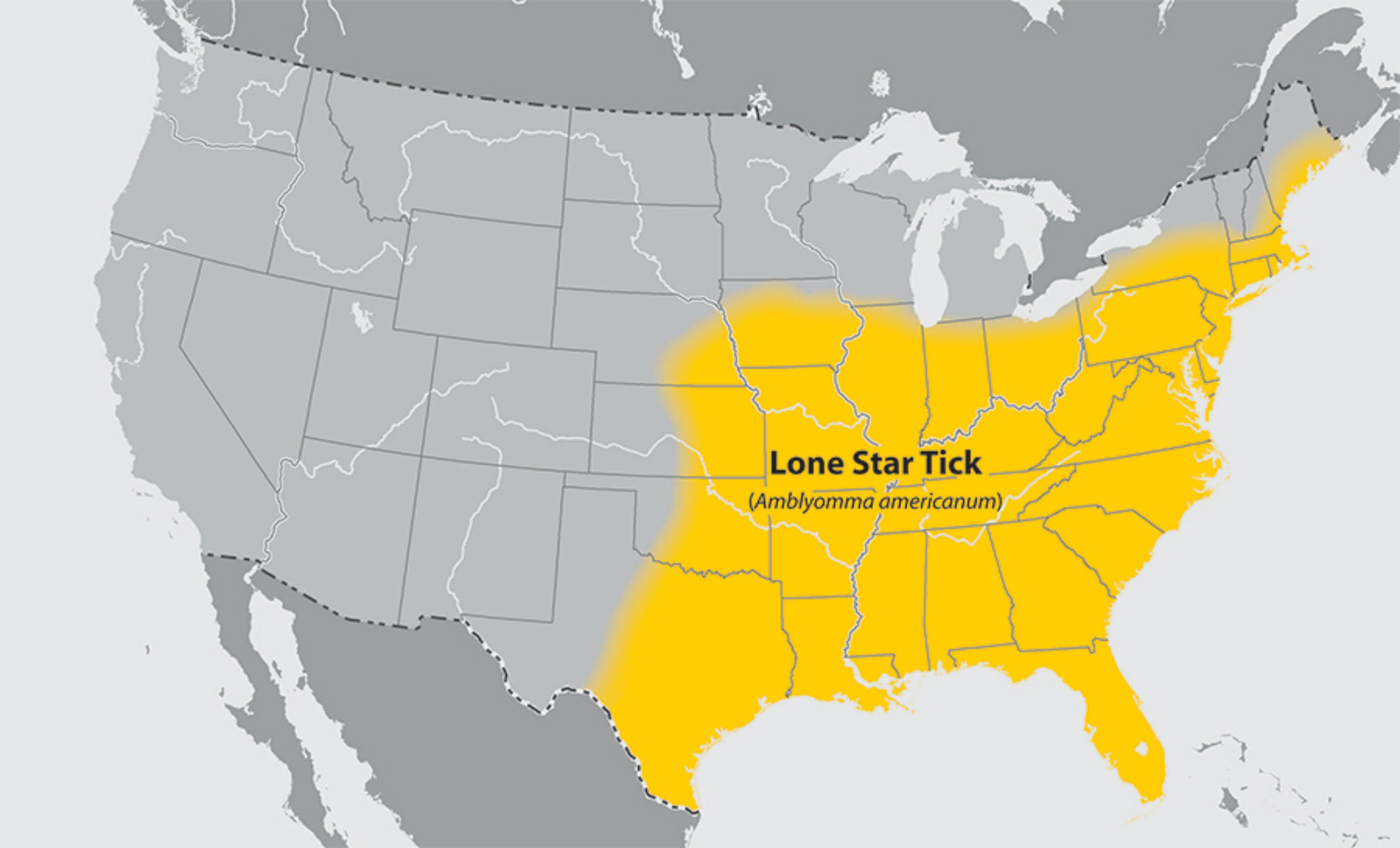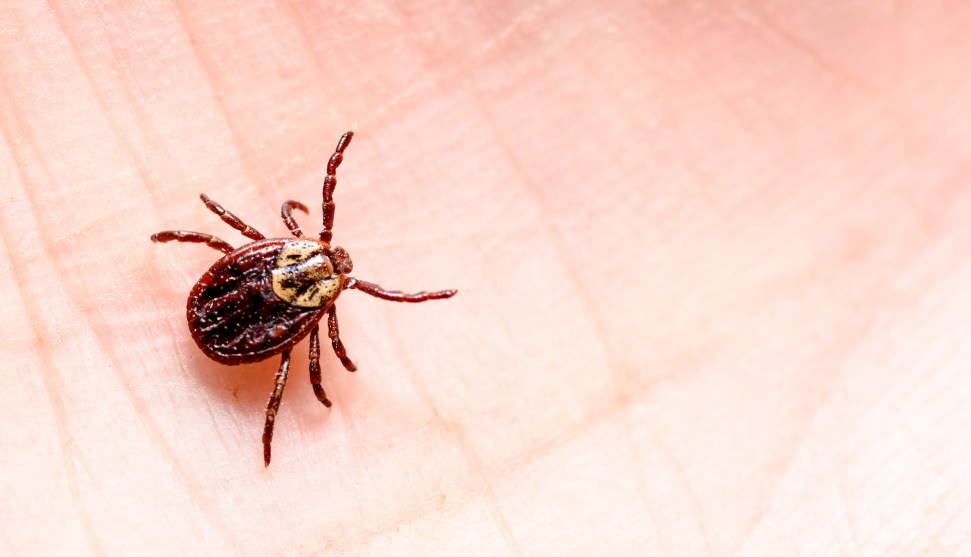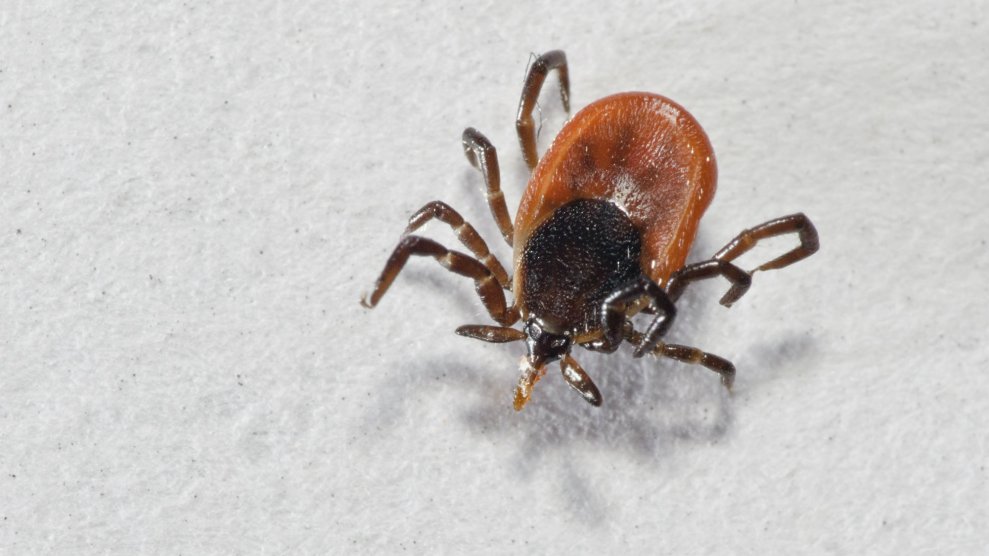
This story was originally published by Grist and appears here as part of the Climate Desk collaboration.
When Peter Coughlin was in his sophomore year at James Madison University in northern Virginia, he was besieged by a strange and unsettling illness. At random times throughout the night, Coughlin would wake up with hives, full body chills, and raging fevers. These episodes always ended up with him in the bathroom, throwing up until his stomach was empty.
After keeping a food journal for nearly a year, Coughlin realized his symptoms occurred after eating meat, primarily pork. “I essentially spent a week proving my point,” Coughlin says. “I’d eat a bunch of red meat, and go through a series of pretty severe reactions.”
When he finally went to the hospital in 2016, the doctor tested him for all the usual allergies and was flummoxed by the lack of results. She gave him a strong antihistamine and an EpiPen and sent him home.
Frustrated, Coughlin started researching. He found similarities between his symptoms and documented cases of something called alpha-gal allergy. A major study on the allergic reaction had been done right across the Blue Ridge Mountains at the University of Virginia.
Suddenly, his hiking trips in that very mountain range came into focus: “I kept pulling ticks off of me,” he says. According to the research, those little brown bugs, marked by a telltale white spot, were to blame for his meat allergy. Coughlin was bit by lone star ticks.
Alpha-gal isn’t your typical hayfever-like allergy. It’s a severe, delayed-reaction immune response, which means it hits hours after someone who suffers from the allergy eats meat. People with alpha-gal describe their episodes as terrifying experiences that can land you in the emergency room and change the way you live your life.
“I was disheartened,” Coughlin says. “I’m a big eater.”

Even a decade ago, only small populations of lone star ticks were found in the northeastern US. As climate change shifts temperatures and humidity levels across the country, many types of ticks, which thrive in warm, humid weather, are able to expand their ranges. The EPA even uses Lyme disease, which is transmitted by blacklegged ticks, as an indicator to track where the country is warming. The spread of lone stars has been linked to climate change, and now, the ticks have made it all the way up through Maine, imparting severe red meat allergies on unsuspecting carnivores—and offering a window into our changing world and its effect on human health.
As lone stars expand into new communities this summer, the ticks are poised to catch people off guard. And just like Coughlin, these little fellows are big eaters.
As you read this, millions of tiny, black-and-brown-legged creatures are beginning to reawaken after laying dormant underneath layers of last year’s leaf cover.
Ticks are only second to mosquitoes as vectors for human disease. This week, the Centers for Disease Control and Prevention published a report showing illnesses from ticks, fleas, and mosquitoes are on the rise. Disease cases in the US more than tripled between 2004 and 2016, and the report found that we’re ill-equipped to tackle the growing problem.
Large swaths of the eastern US are already dealing with an epidemic of Lyme disease, an illness that can rob you of your short-term memory, your motor functions, and, very rarely, even your life.
And every so often, it seems, the ticks that rouse themselves from the leaf litter are armed with unexpected and mysterious pathogens, like the resurfaced Powassan virus or Pacific Coast tick fever. The CDC report says seven new tick-borne infections have been recorded since 2004. The organization hasn’t recognized alpha-gal allergies yet.
“It’s scary,” says Graham Hickling, the director of the University of Tennessee’s Center for Wildlife Health. “Pretty much every year, we’re finding something new.”
A combination of factors has allowed lone stars to conquer territories far outside their known range.
Climate change is among them. It’s likely affecting the viability rates for the thousands of eggs that a single lone star can lay at a time. “When we start getting these warm seasons, high rainfall kind of years, that probably means that those 2,000 baby ticks do a lot better,” Hickling says.
That’s not the only way climate change is aiding survival rates. Many ticks go dormant during the winter, when consecutive below-freezing days and nights turn them into sesame-sized popsicles. But as warming keeps taking days out of the region’s cold season, ticks are able to stay active for longer.
Hickling says a benign climate is helpful for ticks and what they carry: “There are more opportunities for those viruses to start infecting us.”
Holly Gaff, a tick-borne disease expert at Old Dominion University in Norfolk, Virginia, also points to one of the tick’s favorite hosts, the white-tailed deer. Deer can travel several miles in the days or even weeks it takes for lone stars feed on them, eventually dropping the ticks a long way from where they first picked them up. Reforestation efforts in the eastern US that began in the 20th century, coupled with a slump in hunting, have led to an explosion in white-tail deer populations. The growth of suburbs means there are plenty of people pressed up against these wooded areas.
Gaff calls this combination of factors—higher deer populations, people living next to fragmented forests, a friendlier climate—the “perfect storm” for lone star–tick proliferation. “When you have nature in balance you get some ticks, but not like this,” Gaff says.
Already, at least 600 known cases of alpha-gal have occured north of the Mason-Dixon line, according to University of North Carolina allergist Scott Commins, one of the researchers who discovered the connection between ticks and alpha-gal. But that’s probably only a fraction of the incidences. It’s a difficult pathology to diagnose, and doctors aren’t required to report alpha-gal to the CDC.
Compared to blacklegged ticks, lone stars are much more aggressive. Blacklegged ticks behave in predictable ways—they hang out in leafy undergrowth, arms and legs outstretched in case a hapless animal or human passes by. According to Ellen Stromdahl, a researcher with the United States Army Public Health Center, blackleggeds are relatively small and weak.
Lone stars, on the other hand, hunt in packs and travel at surprising speeds, emerging from the leaf litter like a swarm of thirsty, galloping lentils.
“If you sit in the middle of the woods breathing out CO2, you’ll get a fan club of lone stars pretty quickly,” Hickling says.
On top of lone stars’ rapacious mentality, Old Dominion’s Gaff says that after conducting a series of experiments, the bugs “seem to be invincible.”
She’s tried freezing them—but they came crawling out of the freezer after seven days on ice. Next, she tried drowning them, figuring that sea-level rise on Virginia’s coast could end up doing humanity a favor by drowning out tick populations. Her team submerged lone stars in salt, fresh, and brackish water. Every single tick lasted for at least 30 days in each condition—the last lone star died after 74 days.
It only takes one bite from a lone star tick for an unsuspecting victim to develop a meat allergy that can last months, years, or even an entire lifetime.
Here’s how scientists think it goes down: Alpha-gal is a sugar molecule found in nearly all mammals, except humans and a few other primates. A lone star carrying alpha-gal (or an alpha-gal-like substance) bites a person and spreads it to their blood through the tick’s saliva. Then, the molecule essentially rewires the body’s immune system, prompting it to produce an overload of alpha-gal antibodies. When that person goes in for a cheeseburger, their body has a life-threatening reaction to the sugar in the meat.
As recently as a few years ago, the link between lone stars and this allergic reaction was controversial. In 2011, a team of University of Virginia allergists presented its hypothesis in front a group of tick experts. The scientists’ reaction was dismissive.
“We thought, ‘These guys are full of stuffing,’” Gaff recalls.
That team was led by Thomas Platts-Mills, who initially made the connection between lone stars and alpha-gal. Platts-Mills applied insights from his study of patients who were taking the cancer drug cetuximab. Some patients were allergic to the drug, which contains alpha-gal. The team looked into what could be causing the reaction and discovered the linkbetween lone stars and alpha-gal antibodies.
As more people started turning up in emergency rooms with sudden and inexplicable reactions to meat, other researchers began coming around to the idea that a sesame-sized insect could, in fact, instill a lifelong aversion to red meat in full-sized human beings. Platts-Mills is now working on mapping cases of the allergy.
One such case took place in Lake of the Ozarks, Missouri. John Beckett, a self-professed meat lover, was besieged by a pack of lone stars when he was cleaning out underbrush from an old car lot in 2014. Two weeks later, he was chowing down on hamburgers with some friends at a dock party on the lake when he started breaking out in hives.
Over time, Beckett figured out that he felt sick every time he ate red meat.
The hives weren’t enough to make him stop, though. It wasn’t until he wound up in the emergency room—after eating a cowboy rib eye from one of his favorite restaurants—that he decided to kick red meat out of his diet once and for all. “The hives had closed my airways,” Beckett says. “I thought I was going to die that night.”
When he finally went to an allergist and got his blood tested, his doctor told him the levels of alpha-gal antibodies in Beckett’s system were the highest he had ever seen. “You gave me bragging rights,” Beckett remembers his doctor telling him.
That was four years ago. Beckett stopped eating meat, and the amount of alpha-gal antibodies in his blood declined only slightly.
Mark Vandewalker, an allergist who’s been treating patients in Missouri since 1990, has noticed an uptick in patients exhibiting anaphylaxis, or a systemic allergic reaction, to meat. He sees patients come in with hives, swelling, itching, and, occasionally, some respiratory difficulties.
“Initially, I didn’t even believe that the condition was real,” Vandewalker says. “But now, having seen so many cases of my own, I think that it’s impossible to deny that this is a very unusual, but a very real, form of food-induced anaphylaxis.”
The vast majority of food-related anaphylaxis occurs within minutes after eating, but alpha-gal is one of the rare allergies that doesn’t work that way.
“What’s odd is that it’s happening in the middle of the night,” Vandewalker explains. “These episodes have occurred three, four, five, even up to eight hours after eating.”
That makes it harder to diagnose, which is why patients with alpha-gal are often sent home from medical facilities without answers.
On a trip to visit his family in Leesburg, Virginia, last year, Peter Coughlin was bitten by a blacklegged tick. He contracted Lyme disease, which required him to go on a regimen of antibiotics.
A few months later, he reunited with a bunch of his high school friends, and the group decided to go out to eat. It had been two years since his alpha-gal symptoms began popping up, and Coughlin explains he was ready to jeopardize his health in the name of grilled steak.
“I just said, ‘Fuck it,’” he recalls. “I filled my pocket with Benadryl and went to Korean barbecue.”
This time Coughlin didn’t have an allergic reaction. The Benadryl he had brought stayed in his pocket.
According to Vandewalker, the Missouri physician, alpha-gal can eventually retreat to the point where eating red meat again is possible. Doctors and researchers don’t know, however, how long the antibodies will linger patient to patient—remember, John Beckett’s levels were still high four years after he was bit—and they don’t know how to counteract it besides telling patients to lay off the red meat.
Though alpha-gal remains somewhat mysterious, there is some good news about the ticks that carry it. While in some areas up to 50 percent of blacklegged ticks carry some kind of infectious disease—Lyme, Babesia, Anaplasmosis—the rate of transmissible illnesses found in lone stars (like Rocky Mountain Fever) is much lower, around 10 to 20 percent. What’s more, a recent study published by the Army Public Health Center indicates that lone stars can’t carry Lyme disease at all. Stromdahl, the Army entomologist, surveyed 54 studies from 35 different research groups involving 52,000 ticks and found that a chemical in lone star saliva kills Borrelia—the bacteria that causes Lyme.
“You never want to say never with ticks or insects and what they can carry,” she says. “But we presented a lot of evidence that they don’t.”
But the reality is that we’re living in a warming world, and one of the consequences of that is a tick expansion. And while a group of scientists is working on a vaccine for alpha-gal, others are devising ways to attack the issue at its root—by eliminating the ticks from highly populated areas.
Gaff at Old Dominion conducts studies using a robot called a tickbot, which moves around dragging a rag soaked with permethrin (a common treatment for lice that also kills ticks). The bot, which has a little piece of dry ice embedded in its center, breathes out CO2 and attracts ticks to the toxic rag.
Richard Ostfeld, a disease ecologist at the Cary Institute of Ecosystem Studies in Upstate, New York, is conducting tick experiments on entire neighborhoods, which he calls “tick towns.” Twenty-four communities volunteered for the experiment, and some are outfitted with a naturally occurring fungus that sucks the life force out of ticks. Others have little contraptions called “bait boxes” that dab rodents with a small dose of Frontline, the flea and tick medicine for cats and dogs. According to Ostfeld, these preventive measures are “probably our best hope at clobbering ticks.”
Tickbots and tick towns aren’t much comfort to people already living with Lyme or alpha-gal, but they’re our best shot at keeping people who are still unaffected safe. For the alpha-gal allergic among us, the spread of lone stars means the end of traditions that once seemed reassuringly permanent—like eating hamburgers at a dock party on the Lake of the Ozarks. Those get-togethers aren’t what they once were for John Beckett. But he’s playing the long game.
“I’m trying my best not to get bitten a second time,” he says, adding he reckons his blood levels will have evened out in a few decades. “By the time I’m 80 I might be able to eat meat again.”
















